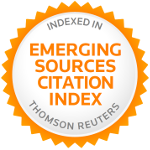Impact of COVID-19 on Higher Education in Pakistan : An Exploratory Study
DOI:
https://doi.org/10.46661/ijeri.5645Keywords:
Pandemic, online learning, interaction, regressionAbstract
The outbreak of novel coronavirus infection (COVID-19), reported initially in December 2019 by China, has caused disruption all over the world. To control the spreading of this virus all the countries around the world imposed strict lockdown leading to shutting down of all businesses, educational institutions, entertainment centers, etc. Higher Educational Institutions (HEI), across the world, switched to online mode of learning instantly to continue their degree programs. Following the trend, Higher Education Commission of Pakistan encouraged HEIs to begin online classes. Although, online learning seemed to be the best possible solution during indefinite closure of institutes, but the sudden change in teaching and learning paradigm was not well accepted and unprecedented challenges emerged. This study aims at identifying the barriers specific to students and teachers in this abrupt shift. Moreover, it examines the satisfaction level of undergraduate students regarding online education practices during the COVID-19 epidemic. The study employed survey design and carried it out through two distinct questionnaires that are, for students and teachers which were distributed online via social media platforms. A total of 1280 students participated in students’ questionnaire while 112 teachers contributed to filling out teachers’ survey. Content Quality (CQ), Content Availability (CA), Teacher Interaction (TI), and Mode of Lecture Delivery (MLD) were considered as the predictor variables for student satisfaction. Regression and correlation analyses were performed to find out the contribution of the aforementioned variables. The survey results concluded that the lack of interaction among students and teachers is the major hurdle in online learning. Regression results revealed that the overall model with all four predictors was significantly predictive of student satisfaction. The results further revealed that MLD is the strongest and most significant of all. We believe the findings of this study can provide beneficial insights in improving the paradigm shift with greater efficiency in this pandemic.
Downloads
References
Ali, A., Ramay, M. I., & Shahzad, M. (2011). Key factors for determining student satisfaction in distance learning courses: A study of Allama Iqbal Open University (AIOU) Islamabad, Pakistan. Turkish Online Journal of Distance Education, 12(2), 114–127. https://doi.org/10.17718/tojde.10766
Alqurashi, E. (2019). Predicting student satisfaction and perceived learning within online learning environments. Distance Education, 40(1), 133–148. https://doi.org/10.1080/01587919.2018.1553562
Baber, H. (2020). Determinants of Students’ Perceived Learning Outcome and Satisfaction in Online Learning during the Pandemic of COVID-19. Journal of Education and E-Learning Research, 7(3), 285–292.
CDC. (2020). How to Protect Yourself; Others | CDC. https://www.cdc.gov/coronavirus/2019-ncov/prevent-getting-sick/prevention.html
Chen, T., Peng, L., Yin, X., Rong, J., Yang, J., & Cong, G. (2020). Analysis of User Satisfaction with Online Education Platforms in China during the COVID-19 Pandemic. Healthcare, 8(3), 200. https://doi.org/10.3390/healthcare8030200
Demuyakor, J. (2020). Coronavirus (COVID-19) and Online Learning in Higher Institutions of Education: A Survey of the Perceptions of Ghanaian International Students in China. Online Journal of Communication and Media Technologies, 10(3), e202018. https://doi.org/10.29333/ojcmt/8286
ECW. (2020). COVID-19 AND EDUCATION IN EMERGENCIES - educationcannotwait. https://www.educationcannotwait.org/covid-19/
Haelle, T. (n.d.). Why Everything Is Closing For Coronavirus: It’s Called ‘Flattening The Curve.’ Retrieved July 16, 2020, from https://www.forbes.com/sites/tarahaelle/2020/03/13/why-everything-is-closing-for-coronavirus-its-called-flattening-the-curve/#d4b99b86e2b1
Hahn, B. (n.d.). How people learn best: Active vs Passive Learning – The Learning Hub. Retrieved July 16, 2020, from https://learninghub.openlearning.com/2018/12/10/how-people-learn-best-active-vs-passive-learning/
Harasim, L. (2000). Shift happens: online education as a new paradigm in learning. The Internet and Higher Education, 3(1–2), 41–61. https://doi.org/10.1016/S1096-7516(00)00032-4
Hill, P. (2012, November). Online Educational Delivery Models: A Descriptive View. EDUCAUSE Review. http://www.learntechlib.org/p/113883/
Joksimović, S., Gašević, D., Loughin, T. M., Kovanović, V., & Hatala, M. (2015). Learning at distance: Effects of interaction traces on academic achievement. Computers & Education, 87, 204–217. https://doi.org/10.1016/J.COMPEDU.2015.07.002
Karada, E. (2020). Coronavirus Pandemic : An Evaluation Study for Undergraduate Students. Journal of Higher Education (Turkey), 1–12. https://doi.org/10.2399 / yod.20.730688
Kuo, Y.-C., & Belland, B. R. (2016). An exploratory study of adult learners’ perceptions of online learning: Minority students in continuing education. Educational Technology Research and Development, 64(4), 661–680. https://doi.org/10.1007/s11423-016-9442-9
Kuo, Y. C., Walker, A. E., Schroder, K. E. E., & Belland, B. R. (2014). Interaction, Internet self-efficacy, and self-regulated learning as predictors of student satisfaction in online education courses. Internet and Higher Education, 20, 35–50. https://doi.org/10.1016/j.iheduc.2013.10.001
Kuo, Y., Walker, A. E., Belland, B. R., & Schroder, K. E. E. (2013). A predictive study of student satisfaction in online education programs | Kuo | The International Review of Research in Open and Distributed Learning. The International Review of Research in Open and Distance Learning, 14(1). http://www.irrodl.org/index.php/irrodl/article/view/1338/2416
Lee, J.-W. (2010). Online support service quality, online learning acceptance, and student satisfaction. The Internet and Higher Education, 13(4), 277–283. https://doi.org/10.1016/j.iheduc.2010.08.002
Li, Q., & Akins, M. (2005). Sixteen myths about online teaching and learning in higher education: Don’t believe everything you hear. TechTrends, 49(4), 51–60. https://link.springer.com/content/pdf/10.1007/BF02824111.pdf
Liang, R., & Victor, D.-T. (2012). Online Learning: Trends, Potential and Challenges. Creative Education, 3(8), 1332–1335. https://doi.org/http://dx.doi.org/10.4236/ce.2012.38195
Liu, W., Peiris, R., Choi, Y., Cheok, A. D., Mei-Ling, C. L., Theng, Y.-L., Nguyen, T. H. D., Qui, T. C. T., & Vasilakos, A. V. (2009). Internet-enabled user interfaces for distance learning. International Journal of Technology and Human Interaction (IJTHI), 5(1), 51–77.
Martin, F., Sun, T., & Westine, C. D. (2020). A systematic review of research on online teaching and learning from 2009 to 2018. Computers & Education, 159, 104009. https://doi.org/10.1016/J.COMPEDU.2020.104009
Means, B., Neisler, J., & Associates, L. R. (2020). Suddenly Online: A National Survey of Undergraduates During the COVID-19 Pandemic. Digital Promise. https://digitalpromise.dspacedirect.org/handle/20.500.12265/98
Moore, J. C. (2005). The Sloan Consortium Quality Framework And The Five Pillars. The Sloan Consortium.
Moore, M. G. (1989). Editorial: Three types of interaction. American Journal of Distance Education, 3(2), 1–7. https://doi.org/10.1080/08923648909526659
Pakistan Today. (2020). HEC orders all universities to begin online classes | Pakistan Today. https://www.pakistantoday.com.pk/2020/03/30/hec-orders-universities-begin-online-classes/
Restauri, S. L., King, F. L., & Nelson, J. G. (2001). Assessment of Students’ Ratings for Two Methodologies of Teaching via Distance Learning: An Evaluative Approach Based on Accreditation. https://eric.ed.gov/?id=ED460148
Routman, R. (2005). Writing essentials : raising expectations and results while simplifying teaching. Heinemann. https://books.google.com.pk/books/about/Writing_Essentials.html?id=3nfuAAAAMAAJ&redir_esc=y
Sahu, P. (2020). Closure of Universities Due to Coronavirus Disease 2019 (COVID-19): Impact on Education and Mental Health of Students and Academic Staff. Cureus, 12(4), e7541. https://doi.org/10.7759/cureus.7541
Sears, C. R., Boyce, M. A., Boon, S. D., Goghari, V. M., Irwin, K., & Boyes, M. (2017). Predictors of student satisfaction in a large psychology undergraduate program. Canadian Psychology/Psychologie Canadienne, 58(2), 148–160. https://doi.org/10.1037/cap0000082
Shuey, S. (2002). Assessing Online Learning in Higher Education. Journal of Instruction Delivery Systems, 16(2). https://eric.ed.gov/?id=EJ657776
Tobin, & J, T. (2004). Best Practices for Administrative Evaluation of Online Faculty. Online Journal of Distance Learning Administration, 7(2). https://www.westga.edu/~distance/ojdla/summer72/tobin72.html
Visser, J. A. (2000). Faculty work in developing and teaching web‐based distance courses: A case study of time and effort. American Journal of Distance Education, 14(3), 21–32. https://doi.org/10.1080/08923640009527062
World Health Organization. (2019). Coronavirus disease (COVID-19). https://www.who.int/emergencies/diseases/novel-coronavirus-2019
World Health Organization. (2020a). Protective measures Covid19 - Stay Healthy at Home. https://www.who.int/southeastasia/outbreaks-and-emergencies/novel-coronavirus-2019/protective-measures/stay-healthy-at-home
World Health Organization. (2020b). WHO Director-General’s opening remarks at the media briefing on COVID-19 - 11 March 2020. https://www.who.int/dg/speeches/detail/who-director-general-s-opening-remarks-at-the-media-briefing-on-covid-19---11-march-2020
Zeidner, R. (n.d.). Coronavirus Makes Work from Home the New Normal. Retrieved August 20, 2020, from https://www.shrm.org/hr-today/news/all-things-work/pages/remote-work-has-become-the-new-normal.aspx
Downloads
Published
How to Cite
Issue
Section
License
Copyright (c) 2021 Tehreem Qamar Qamar, Narmeen Zakaria Bawany

This work is licensed under a Creative Commons Attribution-NonCommercial-NoDerivatives 4.0 International License.









